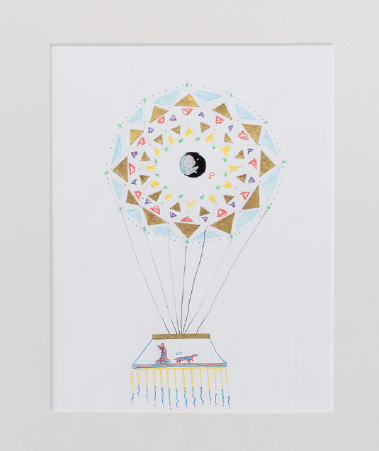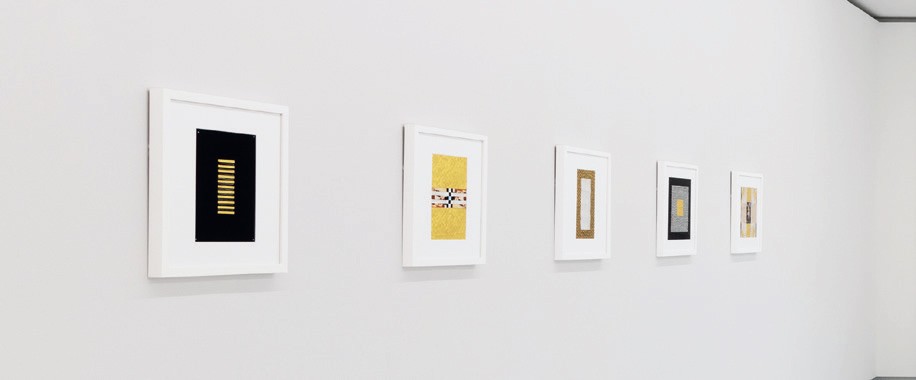John Devlin
“Out of a Heart of Quiet” is the first solo exhibition in Canada by artist John Devlin outside of his home province of Nova Scotia. The exhibition was curated by Kate Whiteway and presented at Erin Stump Projects, Toronto. Devlin’s work has long been contextualized by his biography. Avoiding the pejorative moniker of “outsider” as applied to artistic output not tethered to normative modes of production and dissemination (the artist refers to his own work as a form of Art Brut), Devlin’s practice often reflects notions of the isolation he experienced in his lifetime. Through an abridged interpretation of formative experiences, the sites and methodologies presented in the artist’s immense and exquisite body of artistic output become frames for windows into his quiet world.

John Devlin, Untitled (Cosmic Series 2), 2017, mixed media and gold leaf on paper, 27.94 × 21.6 centimetres. Photo: LF Documentation. Courtesy Erin Stump Projects, Toronto.
At 25 years old John Devlin converted to Catholicism and moved from his family home in Halifax to study theology at the University of Cambridge. While a student, the exhibition’s press release outlines, Devlin fell in love with a priest. Perhaps contextualized within a time of heightened prejudice towards the anti-normative, underscored by Thatcherism and compounded within an arena that defined homosexuality as a sin, Devlin endured multiple breakdowns. This resulted in his return to Nova Scotia, undergoing periods of convalescence, never to continue his studies at the college. Devlin’s love might have been unrequited, but it was not fleeting. The artist has stated that “if you are going to have a mental breakdown, the best place to have it is in the Spring and in Cambridge.” The romance of the campus would have a lasting impact, eventually leading to “Nova Cantabrigiensis,” a body of work that has been most widely exhibited and for which he is most known. Produced between 1984 and 1989, the works reference gothic and collegiate architecture found at his beloved Cambridge. However, Devlin envisioned a composite city constructed on a fictional utopian island within the Minas Basin of Nova Scotia. The series, amassing 365 drawings, provides whimsically complex plans and elevations for his fantastical city, all composed to dwarf any figures that exist within his world of ornate buildings, underscoring the power and majesty of the institution as a figure of knowledge, dominance and authority.
“Out of a Heart of Quiet” shifts away from heavily embellished façades to a much more reduced, if at all fully articulated, relationship to architecture as corresponding subject. Turning inward, the artist explores more ephemeral compositions of the cosmos, where the page becomes a vantage point onto an expanse of floating planets, constellations and esoteric symbols. “Untitled (Cosmic series 1–5),” a series ranging between 2016 and 2018, articulates a sparseness that dusts away the worlds of stuffy baroque empire, allowing for a free flow of movement between disparate objects, spirits and spacefaring devices. Devlin’s cosmos is traversed using seemingly rudimentary combinations of lines and dots. Design for a Spaceship to Neptune and Design for a Spaceship to Venus, both 2014, indicate his continued exploration of design principles founded in architecture, with these compositions evoking blueprints for church colonnades. Devlin will often scan his drawings and invert the colours in Photoshop, turning the stark white ground into an infinite black, placing the elements of the composition into an expansive night sky—a nod to his adolescent curiosities in photographing stars through his telescope. Counting systems, such as number sequences and dots, are utilized throughout Devlin’s oeuvre, their divine ratios incurring a relationship between his art and his spirituality. Out of a Heart of Quiet, 2014, the exhibition’s namesake, employs a similar system of loose formal marks but here indicating a torso. The abstracted figure levitates over a crude geometric altar, conflating the body and building into a unified sacrament.

John Devlin, installation view, “Out of a Heart of Quiet,” Gallery Erin Stump Projects, Toronto, 2022. Photo: LF Documentation. Courtesy Erin Stump Projects, Toronto.
Precious metals of gold and silver appear in the artist’s collage works. At times painstakingly tiled into dense patterns, their use calls up a history of icon painting where gold has played a crucial role in bridging the physical realm with that of the divine. Devlin’s ongoing relationship to spirituality comes through here as a history of trauma, the erotic and the techniques used in the manufacture of belief. In several gilded works the artist combines collaged images of the male phallus in various states of arousal, placed within a formal cross-like geometry of the composition. Untitled (I have a psychosexual disorder), 2016, repeats the title phrase in 22 mirrored lines. This repetition connotes a kind of discipline, or penance—emphasizing Devlin’s powerful connection of spirituality with desire, and the crucifix as a long-standing substrate for the artist’s interpretation of both.
A recurring motif of a densely outlined figure, liberated from its head and limbs, appears in numerous works on exhibit. Three share a context of horizontality that shifts with each drawing, through the organization of the interior space in which the figure resides. Untitled (Crucifix), 2015, renders the figure crucified, with single turquoise dots indicating the location of nails where the hands and feet would affix. Sequentially, Untitled (Crucifix above the bed), 2015, shows the figure lying on a bare mattress, with a cross secured to the wall above where a head would rest. Untitled (Bacchus reclining), 2015, shifts further by adding the comforts of a blanket, pillow and a wineglass while removing any remnants of religious iconography. Bacchus, the Roman god of wine and pleasure, has been depicted perhaps most famously by Caravaggio, with one version described as “a body dedicated to sensuality rather than a soul infected with Christianity.” This delicately sparse trio infers a constellation of Father, Son and Holy Ghost—yet Devlin’s universe is tethered to the corporeal form, a fulcrum between scales of the heavenly body and temptations of its earthly delights.
“Out of a Heart of Quiet” might be considered inchoate or to reside exterior to traditional margins, but that would be a misconception. Devlin is an impeccable draughtsperson, utilizing a very precise set of ratios, sequences and reference points that create an expanded cosmology and transcend that artist’s own periods and subjects, all articulated by his sensitive line work. This art offers an opportunity to explore the complexities of one’s own interior universe, one not limited to the confines of canonization. As Gaston Bachelard describes in his Poetics of Space, the “outside and inside are both intimate—they are always ready to be reversed, to exchange their hostility.” This inversion is where isolation becomes a tool in the creative act to navigate the hostility of being both inside and out, human and divine, simultaneously. Here is the site of Devlin’s art, exposed but not vulnerable. When he is working at his grandmother’s writing desk, his heart is as a desiring vessel, a vessel the artist has designed to transcend the hostile landscapes of interiority and exteriority, the realms of human and divine, to travel deeper into the quiet expanse of his infinite universe and its imaginative unknowns. ❚
“Out of a Heart of Quiet” was exhibited at Erin Stump Projects, Toronto, from July 30, 2022, to August 27, 2022.
Alex Turgeon is an artist from Canada. His artwork, research and teaching centre on how poetry and architecture inform definitions of the queer experience as a built environment.

